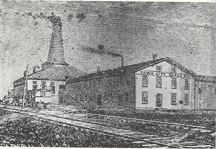
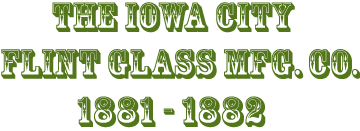
 |
 |
| In 1880 the Iowa City Flint Glass Mfg. Co. began in Keota, Iowa but shortly thereafter moved 40 miles northeast to Iowa City, IA where it was incorporated April 30, 1880. On June 9, 1880, the plant site was purchased from two pieces of land. Incorporators of the company were R. J. Coulter, W. H. Brainerd, entrepreneur Ezekiel Clark, legendary local banker,and J. Harvey Leighton, Supt., the only one of 10 investors with experience with glass production, & others. In December of that year, company representatives went to Pittsburgh to purchase molds. Production started in 1881 during a period of overproduction of tableware glass and competition from Eastern factories was intense. |
| John Harvey Leighton, born about 1849, had come to a glass factory at Keota in 1879 from Wheeling, W.V., where he had been a glass blower at Hobbs, Brockunier & Co. When the Keota operation failed within a year, he moved on to Iowa City. He is the probably source of some – perhaps most – of the molds used for products. He descended from a long line of glass men. --- His Grandfather was Thomas H. Sr., the father of 7 sons, 6 of whom were glassmen. He succeeded Deming Jarves as Supt. of the New England Glass Co. With his son, William, he invented the first formula for ruby glass in America. --- His Father, John H., Sr., joining the NE Glass Co. at age 13, advanced to master glassblower and succeeded his Father as Supt. at the NE Glass Co. --- His Brother, Henry, was an expert engraver at the NE Glass Co. and, --- His nephew, George W. was a partner at Dalzell, Gilmore and Leighton & patented Findlay Onyx glass. |
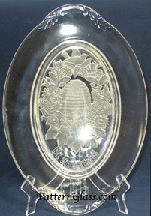 |
| The "Be Industrious" plate is a favorite of Iowa City Glass Collectors. It features a bee hive and the motto for which it is famous. |
| The Iowa City operation was based on the belief that sand from along the Iowa River a few miles south of the plant only needed to be shipped the short distance by rail, and it was an extremely efficient, reliable source. However, early glass from this sand, the principle ingredient in glass, had a tendency to “explode” or shatter as room temperature changes caused gas bubbles to seek release from within the finished product. And so better sand had to be shipped in from Indiana at considerable expense, which proved financially disastrous. The plant was forced to poorer quality products which didn’t prove marketable. |
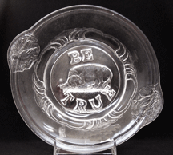 |
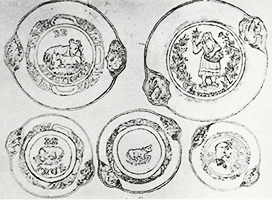 |
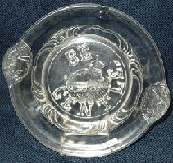 |
| This is the "Be True" plate featuring a dog. | A salesman's sketch of the Iowa City animal motto plates & the Elaine plate, from Righter's book on Iowa City Glass. | This is the "Be Gentle" plate featuring a lamb. |
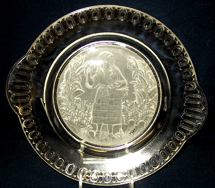 |
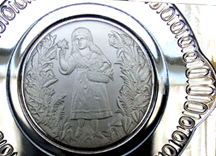 |
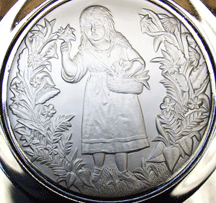 |
| As the patron saintess of PatternGlass.com, the Elaine Plate will be highlighted here. It is 9" in diameter with two bulge type handles and the "oval & bar" (also called "101" or "egg & dart") perimeter design. Many of the factory's plate & other pieces had the center scene frosted. Note the intricate detail of the floral part of this plate. This was characteristic of many of their pieces. The salesman's sketch above shows another design in the handles. |
||
| Other factories produced nearly identical pieces – sometimes from the same molds – making absolute identification as “Iowa City Glass” nearly impossible unless accompanied by original wrappings or written certification. Patterns such as Bleeding Heart and Barberry, the goblets of which Miriam Righter, writing in 1981 attributes to Iowa City Glass Co., were primarily made by other factories. The Iowa City Bleeding Heart goblet is differentiated as having no knob stem and the Barberry goblet has having oval berries. These are not opinions widely held at this time. |
| This is one of the characteristic Iowa City pattern pieces depicting long legged fowl, variously called Storks, Herons, or Cranes. Many of the bread plates or platters in different patterns were produced with both the oval and bar borders & handles and a floral or plain border. These creatures can be found on the ABC plate (see below) and on butter dishes, creamer, goblets, sauce dishes, cov'd sugar bowl and a pitcher. | 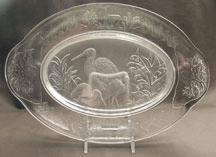 |
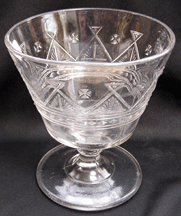 |
Alhambra (sugar bowl missing its lid shown at left) was one of the few actual pattern lines made in a table set. Others were Melon & Leaf, & possibly Deer & Prairie Chicken although only a spooner has been found in the latter. Miscellaneous items made by the factory may include colored marbles, a geometric block wine goblet, a Hat toothpick holder, a few lamps and glass canes. |
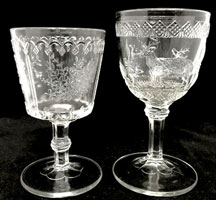 |
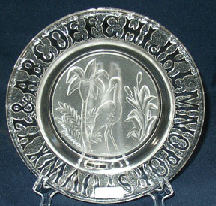 |
| Two of the scarce goblets made by this factory. On the left is one called Sage & on the right is one with a resting Doe, a running Elk and a Standing Elk around the sides. |
ABC plates were made by a small number of pattern glass factories. This is one of two known to have been made at Iowa City. The other one has an elephant in the center. |
 |
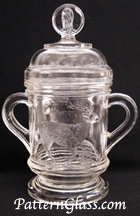 |
| Animals seemed to be a central theme for this factory's patterns. This is a scarce toy complete table set in the "Lamb" pattern. | This is the Running Elk mentioned in Dr. Carberry's supplement to Richter's book. In other EAPG books, it is called Lone Elk. It is rare with the Owl in Ring glass lid. |
| Identifiable pieces can command several hundred dollars each; truly rare ones even more. Goblets claimed to have been made in Iowa City include Sage, Deer or Elk, Elephant (aka Jumbo but not part of the pattern line by that name), Cat, Rabbit & Horse, & possibly Ivy Band, Cantilever & Garter Band. Most researchers conclude that only goblets in the Sage pattern were made in Iowa City. The glass was made beginning in early summer 1881 for a period of about 15 months before the plant was closed and its limited assets distributed among creditors. Several railroad cars filled with finished glassware were emptied by creditors for nickels of what they were due. Pieces were given away as premiums by grocers. |
| At its peak, it employed about 150, many of whom came as experienced workers from eastern states, some reportedly sent by competing glass operations as saboteurs to cause the local plant difficulty. Tales claim many were a rough lot who frequented a tavern on a site now serving the University of Iowa engineering building. “Drunken brawls” were reportedly common. |
| References include: Miriam Righter. Iowa City Glass. 1981 Dr. J. W. Carberry. Iowa City Flint Glass Manufacturing Company 1880-1882. Price Guide 1982 John & Elizabeth Welker. Pressed Glass in America: Encyclopedia of the First Hundred Years 1825 - 1925 Antique Acres Press. 1985 |
 |
 |
 |